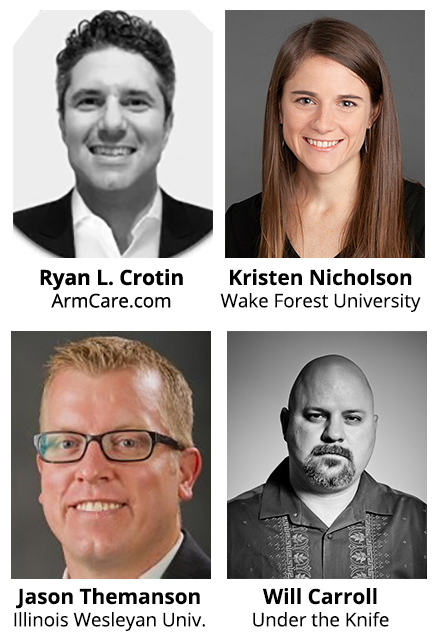2022 SABR Analytics: Watch highlights from the Sport Science and Player Health panel
 At the SABR Virtual Analytics Conference on Sunday, March 20, 2022, we heard a panel discussion on Sport Science and Player Health.
At the SABR Virtual Analytics Conference on Sunday, March 20, 2022, we heard a panel discussion on Sport Science and Player Health.
Panelists included: Ryan L. Crotin, Vice President of ArmCare.com; Kristen Nicholson, director of the Biomechanics and Pitching Laboratory at Wake Forest School of Medicine; Jason Themanson, Professor in the Department of Psychology and the Neuroscience Program at Illinois Wesleyan University; and moderator Will Carroll, author of Under the Knife columns and The Science of Baseball: The Math, Technology, and Data Behind the Great American Pastime.
Here are some highlights:
On the “fight for velocity vs. the fight to prevent injuries”
- Nicholson: “Injury prevention is really the main goal of ours but nobody wants to make changes that will prevent their injury if it is also going to decrease their performance. Velocity is so prized and they’re scouting for it now and everybody wants to get the high velocity, regardless of what that means, especially when you get to this college level. We are really trying to encourage and kind of nail down what might be this pitching efficiency.”
On communication and collaboration between sport science departments
- Crotin: “When it comes to player health and performance, there is always an observation between all of the groups, and you have to put all of the important features into a grinder to determine what are your key variables that impact performance and health. You have to have key data that everyone understands so there is an educational process.”
On if younger athletes can learn from research in neuroscience
- Themanson: “That’s the ideal…From my research it does relate with the kind of positive psychology, sports psychologists measure. Being present, all of those kinds of cliches that you hear about, but if you take them, really take them for what they actually mean and what they’re worth and where to direct your attention…that has been associated with better performance and better outcomes, better mental health, better self-esteem.”
On the value of lab accessibility
- Nicholson: “It’s only going to help the research, the more people that we can get. Coach Walter, the head baseball coach at Wake Forest, said, “The lab isn’t necessarily a money-making venture. The purpose is to help the sport of baseball and reduce these injuries.” The more people that we get through, the more data that we have available to look at these different connections and figure out what’s going on and how we can reduce injuries and keep people in the game longer.”
On if the cognitive load can be measured and eventually scouted in baseball
- Themanson: “I think people have tried to get at that in a number of ways for years by questionnaires and interviews and soft-science skills. I think it’s a real thing. The daily mental grind, I don’t know how you can quantify it…I think there are ways to measure it and I know people try and get at (cognitive load and mental fatigue), but it certainly translates to everything that people talk about in injury and mechanical breakdowns.”
On increasing velocity among baseball pitchers
- Crotin: “The world of baseball is so focused on velocity. I have some friends in the industry who train athletes and they would rather go somewhere to use a weighted ball program than to actually do any kind of strength and conditioning for their bodies. Velocity without command, I don’t think, plays well in later stages of baseball.”
Transcription assistance by Patrick Milum.
For more coverage of the 2022 SABR Virtual Analytics Conference, visit SABR.org/analytics.
Originally published: April 11, 2022. Last Updated: April 11, 2022.


